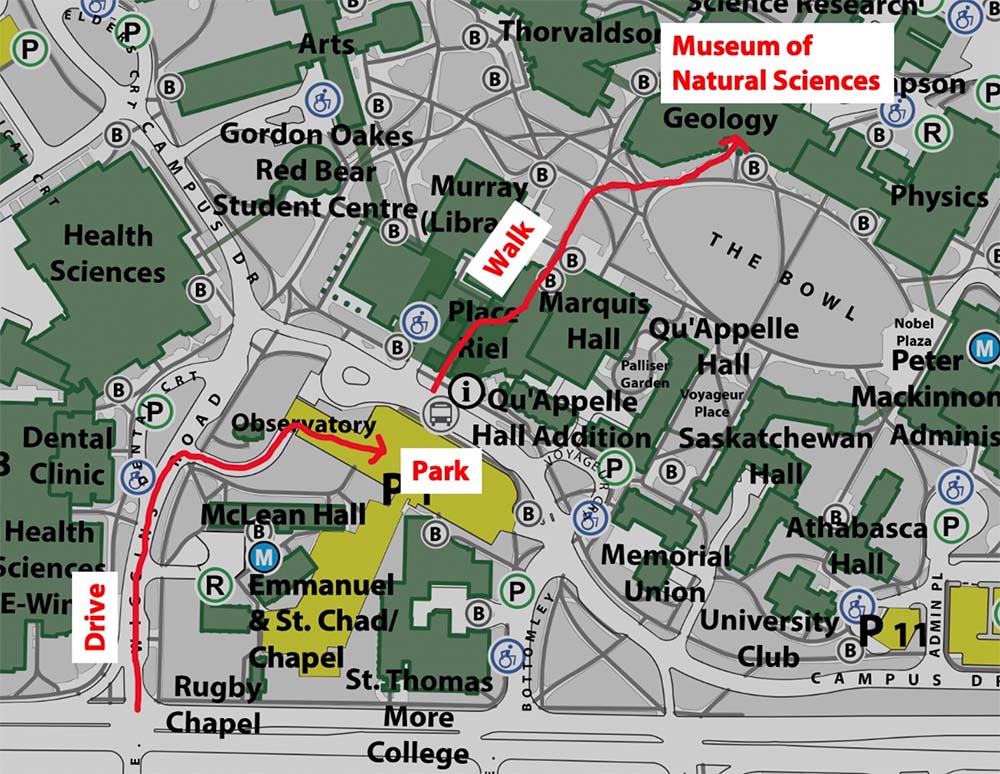
Visit the Museum of Natural Sciences at the University of Saskatchewan to learn about the history of Earth and the evolution of life on it through displays showcasing the natural world and our discoveries in geology, paleontology, biology, and ecology. The museum includes skeleton replicas and live plants and animals in the central atrium, mineral and rock displays in the first floor hallway, fossils and fossil replicas spanning billions of years of life in the second floor hallway, as well as fossil-filled Tyndall Stone walls and benches.
Please note that the museum is located near working classrooms, labs, offices, and study spaces. We also have many artifacts that are fragile and valuable and loud noises or tapping on the glass enclosures will scare the animals. Please do not run or use loud voices and be respectful of others in the museum and in nearby spaces. Children must be supervised by adults.
Hours
- 7am-10pm Monday to Friday
- 10am-10pm Saturday and Sunday
- CLOSED on statutory holidays (and university closures in lieu of)
- CLOSED from December 25 to January 1
In the evenings and early mornings, our fish and other animals need to rest and the aquariums and enclosures may not be lit.
Admission
Location
We are located at 114 Science Place at the University of Saskatchewan in Saskatoon.
Getting Here
The easiest access is through the main doors off The Bowl.

On weekends, only the rightmost power-assisted doors will be unlocked. If you find this door locked, you can get in through the Physics Building adjacent to the Geology Building. If you still can't get in, please call 306-966-5555 and they will come and let you in.
If you are coming by school bus, the best drop-off and pick-up location is 112 Science Place at the Collaborative Sciences Research Building. After you enter, please follow the signs through the buildings to the museum. If you need it, there is bus parking at Lot 20 near Merlis Belsher Place. Another option for getting here is the free Saskatoon Transit Class Trip Program.
Parking
There is metered and paid lot parking on campus. An easy option is parking at Place Riel just off Wiggins road, and then walking through Place Riel to the Geological Sciences building.

Accessibility
The museum and adjacent washrooms are wheelchair accessible, but some of the museum's displays and exhibits may be harder to view.
Connect With Us
@mnaturalsciences_usask
@usaskmnaturalsciences
@usaskmnatsci
museum.naturalsciences@usask.ca
306-966-5729
Mailing address:
114 Science Place
Saskatoon, SK
S7N 5E2
Our Land and Relationships
The Museum of Natural Sciences sits on Treaty 6 territory, the traditional lands of the nēhiyawak, Anihšināpē, Dënësųłinë́, Nakoda, Dakota, and Lakota, and the Homeland of the Métis. We acknowledge, respect, and honour the deep relationship that they have with the natural world, and we are grateful for the opportunity to share in the beauty and nurturance that the land, water, and sky offer.
We acknowledge that Indigenous Peoples have been and continue to be impacted by colonization in many ways, including in scientific research. We strive to build good relationships with the land and people of this place, and we have a responsibility to decolonize its practices and approaches through learning, teaching, and gathering knowledge with Indigenous Peoples as we all journey towards (re)conciliation.
More at USask
The Museum of Antiquities hosts a collection of ancient Greek, Roman, Egyptian, and Near Eastern sculpture in full-scale replica, as well as original pottery, glass, and ancient coinage.
The Kenderdine, College, and Snelgrove Art Galleries showcase work by artists and curators from the university and from the wider local, national, and international community.
In addition to preserving the core collection of John G. Diefenbaker’s personal artifacts, the Diefenbaker Canada Centre hosts exhibits and programs that explore citizenship, leadership, and Canada's role in the international community.
The Observatory houses a 3m long refracting telescope with a 6” diameter lens, and a small museum with exhibits on the solar system and astronomy. Public viewing nights are offered throughout the year.
For more to do on campus, check out some other University of Saskatchewan attractions and popular destinations.